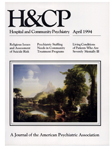CMHC Practices Related to Tardive Dyskinesia Screening and Informed Consent for Neuroleptic Drugs
Abstract
Objective: The authors conducted a national survey of community mental health centers to determine their policies and practices about screening patients for tardive dyskinesia and obtaining informed consent for use of neuroleptic drugs. Methods: Clinical directors of 235 centers in the United States, selected by geographic region and population, were surveyed through a nine-item questionnaire. Results: Although nearly all the 160 respondents reported that they screened patients for tardive dyskinesia, only about two-fifths had formal screening policies, and about two-fifths had screening programs. The Abnormal Involuntary Movement Scale examination was used by almost two-thirds of respondents who screened patients, and about one-fiftb relied on unstructured observation. Slightly more than half of respondents specified a frequency for screening examinations, at a modal interval of six months. Seventy percent used nonpsychiatric clinicians for screening. Almost three-quarters of the respondents had informed consent policies for use of neuroleptics. Urban centers tended to be more aware than rural centers of the American Psychiatric Association's tardive dyskinesia screening guidelines. They also used fewer nonmedical practitioners for screening and were more likely to obtain informed consent for neuroleptics. Conclusions: Despite the existence of APA guidelines and state policies and regulations about tardive dyskinesia screening, a national effort to educate clnicians about prevention of tardive dyskinesia is still needed.
Access content
To read the fulltext, please use one of the options below to sign in or purchase access.- Personal login
- Institutional Login
- Sign in via OpenAthens
- Register for access
-
Please login/register if you wish to pair your device and check access availability.
Not a subscriber?
PsychiatryOnline subscription options offer access to the DSM-5 library, books, journals, CME, and patient resources. This all-in-one virtual library provides psychiatrists and mental health professionals with key resources for diagnosis, treatment, research, and professional development.
Need more help? PsychiatryOnline Customer Service may be reached by emailing [email protected] or by calling 800-368-5777 (in the U.S.) or 703-907-7322 (outside the U.S.).



